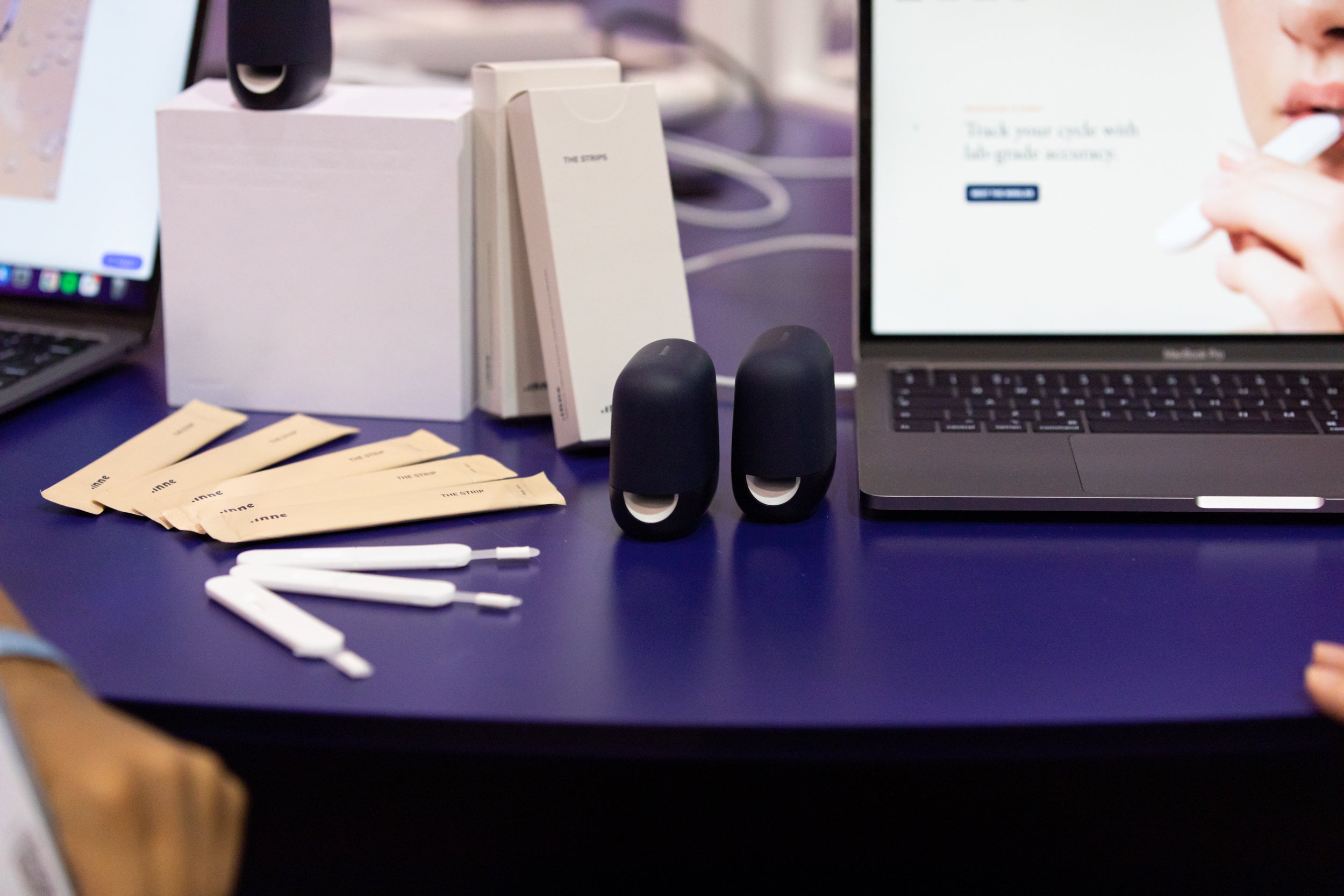When you’re trying to get pregnant, you might be on high alert for early pregnancy symptoms that can sometimes show up even before your missed period. But many early pregnancy symptoms are very similar to other conditions such as premenstrual syndrome (PMS), or even getting sick [1].
So how can you tell the difference?
We’ll break down the most common symptoms of early pregnancy, how to spot them, and when to time a pregnancy test to get the most accurate results.
The Most Common Signs of Early Pregnancy
The main tell-tale sign to look out for when it comes to pregnancy is a missed period. If your period doesn’t come when you’re expecting it, taking a pregnancy test is a good idea—but more on that later.
You also might experience other symptoms even before your missed period, such as [4]:
- More frequent urination
- Fatigue/poor sleep
- Back pain
- Tender and/or swollen breasts
- Nausea and possibly vomiting (especially in the morning)
Some of these symptoms—such as swollen/tender breasts, back pain, and fatigue, can also be present in premenstrual syndrome (PMS), a condition many menstruators experience before their period, so look out for that if these symptoms are part of your typical menstrual experience [5]. However, if many of these symptoms are present—especially ones like nausea that are not typical PMS symptoms—it could indicate that a positive test is on its way soon.
Less Common Signs of Early Pregnancy
There are many more symptoms that can point toward pregnancy, but fewer menstruators tend to experience them. If you’re experiencing some of these symptoms as well, it may be pointing towards pregnancy [4]:
- Changes in nipple colour (often a darkening of the areola)
- Mood swings
- Headaches
- Food cravings
- Constipation
Now that we’ve covered many of the common—and even the less common—symptoms of early pregnancy, let’s dive into another symptom that many experience: bleeding and spotting. This can be a source of anxiety for many, so it’s important to know what’s normal, and what’s not.
Spotting and Bleeding in Early Pregnancy: What’s Normal?
According to an article by the journal Australian Family Physician, 20 – 40% of pregnant people will experience some bleeding in the first trimester [6]. In many cases, light bleeding or spotting in early pregnancy is not a cause for concern [7]. However, some kinds of bleeding can indicate a need for medical attention, so it’s important to know what to look for.
First of all, there is a difference between spotting and bleeding.
Spotting is a small amount of often pink, red, or brown blood that is very light (meaning you would need, at most, a panty liner). You might notice a couple of drops of blood on your underwear, or when you wipe with toilet paper. Light spotting is generally less of a cause for concern, especially in early pregnancy, but should still be brought up with your doctor [7].
Bleeding is a flow of blood that would require a pad or tampon to avoid soiling clothes. If you are experiencing bleeding, it’s important to get in touch with your primary care provider to let them know what you are experiencing, as it could indicate a need for medical attention [7].
Causes of Bleeding and Spotting in Pregnancy
A common cause of spotting in early pregnancy is implantation bleeding. This happens in the time after ovulation, but before a missed period, and it means that the fertilized egg—the blastocyst—has attached itself to the uterine lining, which can cause very light spotting for a few days [7].
Cervical polyps are another cause of spotting during the second trimester. These are harmless growths that can appear on the cervix, and due to irritation of the polyps, are more likely to bleed after activities such as intercourse or a gynaecological exam [7]. Both of these conditions are not generally causes for concern, but should still be discussed with your doctor or midwife.
If you are pregnant, but experience bleeding that is similar to a menstrual period, or if the bleeding is in the second or third trimesters, it’s important to let your healthcare provider know right away, so that they can rule out conditions like ectopic pregnancy.
In general, when in doubt, call your provider and describe what you are experiencing. They may ask you questions about [8]:
- The amount of bleeding
- The colour of the blood
- Whether it fills a panty liner
- Whether there are any clots or tissue present
- Whether you have recently fallen, lifted heavy items, or had intercourse
It’s a good idea to be ready to answer these questions. Even taking a photo of what you’re experiencing can help you to remember the details so that the provider can accurately assess what’s going on.
And most of all, try your best to remain calm. It can be scary to experience bleeding during pregnancy, but remember that many who experience this go on to have healthy pregnancies and babies [7].
Confirming that You’re Pregnant: When Should You Test?
If you’re experiencing many of the symptoms talked about earlier in the article, during the latter half of your menstrual cycle, it’s a good idea to take a pregnancy test.
But how do these tests work, and when should you take one?
Pregnancy tests measure a hormone called human chorionic gonadotropin (HCG). This hormone begins being produced by the body in early pregnancy and normally doubles every 48 hours during this period, and can be detected in a pregnant person’s blood or urine starting from about 10 days after conception [10].
So, if you ovulated on day 14 of your cycle, and you’re expecting your period around day 28, the earliest day that pregnancy could be detectable is around day 24 of your cycle, just a few days before your period is due to arrive.
Home pregnancy tests use urine to detect HCG and indicate whether you are pregnant. However, some home pregnancy tests are not sensitive enough to pick up HCG this early, and may only show a positive result a few days after your missed period.
However, using more concentrated urine that you pass first thing in the morning can help you obtain a more accurate result [9]. If you believe you may be pregnant but an early test is negative, try again for a few days as HCG levels may have been too low to detect on the home test before.
Another option is to head to your healthcare provider’s office, as they can perform a blood test which can pick up lower levels of HCG in your body to confirm whether or not you’re pregnant—sometimes earlier than a home test [9].
So, if you’re experiencing many of the symptoms listed in this article and are approaching (or recently passed) the date of your expected menses, it’s a good idea to pick up a home test first.
If that test is positive, it’s time to schedule an appointment with your healthcare provider to perform a blood test, because this not only confirms the presence of HCG but also measures the quantity of HCG in your blood, which gives you insight into whether the pregnancy is developing normally—the abnormal rising of HCG can signal ectopic pregnancy, for example, or a high level can indicate a molar pregnancy or that you’re having twins [10].
Your doctor may also be able to provide information about your options for unplanned pregnancy. They can talk to you about next steps and point you toward additional resources and professionals who can help with your decision.
Dealing with Pregnancy Symptoms
Once you confirm that you are pregnant and want to continue the pregnancy, you may be wondering how to manage the sometimes uncomfortable symptoms you might experience over the next nine months. There are many things that can help you to feel more comfortable.
If you are experiencing nausea and vomiting, eating small meals throughout the day can help, as well as drinking chamomile tea or eating ginger [11]. You can also speak to your healthcare provider about anti-nausea medication if it’s interfering with your day-to-day activities.
Many experience constipation during pregnancy. To address this, drinking at least two litres of water per day can help (as well as boost your energy). Increasing your fibre intake through food like fruits, veggies, and whole grains is also a good idea [11].
For fatigue, the best remedy is simply prioritizing rest. Take naps throughout the day, and try to get eight hours of sleep at night. And don’t be too hard on yourself, you’re growing another human being inside of you. That takes a whole lot of energy!
As always, if you feel your symptoms are severe, interfering with your daily functioning, or you just aren’t sure if they’re normal, always reach out to your healthcare provider. They’ll be able to put your mind at ease or find a solution to make your symptoms more manageable.
Recap: What to Look for in Early Pregnancy
If you’re trying to get pregnant, there are many signs and signals to look out for that might give you a hint that a positive test might be on its way. It’s important to be informed and know what’s normal and what might need a second look to navigate through this period of early pregnancy.
One of the best ways to be informed and give yourself the best chances of conceiving, if that’s what you’re looking to do, is by tracking your cycles to determine when you are approaching ovulation, as this period is the time you are most likely to get pregnant.
A fantastic way of doing that is through the inne minilab, which uses your saliva to measure your progesterone levels (a key hormone in ovulation) and sends the results right to your smartphone. This gives you lab-grade insights into your body’s hormonal changes, giving you a more accurate picture of your cycles, what to look out for, and when.
References
1. Mayo Clinic Staff. (2021). Symptoms of pregnancy: What happens first. Mayo Clinic. Retrieved from https://www.mayoclinic.org/healthy-lifestyle/getting-pregnant/in-depth/symptoms-of-pregnancy/art-20043853
2. Wilcox, A. et al. (1995). Timing of Sexual Intercourse in Relation to Ovulation — Effects on the Probability of Conception, Survival of the Pregnancy, and Sex of the Baby. N Engl J Med 1995; 333:1517-1521. Retrieved from https://www.nejm.org/doi/full/10.1056/nejm199512073332301
3. Cleveland Clinic. (2021). Cervical Mucus. Cleveland Clinic. Retrieved from https://my.clevelandclinic.org/health/body/21957-cervical-mucus#:~:text=Cervical%20mucus%20plays%20a%20key,uterus%20to%20meet%20an%20egg
4. Foxcroft, K. et al. (2013). Development and validation of a pregnancy symptoms inventory. BMC Pregnancy Childbirth. 2013; 13: 3. Retrieved from https://www.ncbi.nlm.nih.gov/pmc/articles/PMC3599678/#:~:text=The%20top%20four%20%E2%80%9Coften%E2%80%9D%20reported,fold%20during%20the%20study%20period
5. Healthline. (2018). PMS Symptoms vs. Pregnancy Symptoms. Healthline. Retrieved from https://www.healthline.com/health/womens-health/pms-symptoms-vs-pregnancy-symptoms
6. Breeze, C. (2016). Early pregnancy bleeding. Australian Family Physician, 45:5. Retrieved from https://www.racgp.org.au/afp/2016/may/early-pregnancy-bleeding
7. Healthline. (2021). What Causes Spotting in Pregnancy? Healthline. Retrieved from https://www.healthline.com/health/pregnancy/spotting-in-pregnancy
8. Cleveland Clinic. (2021). Bleeding During Pregnancy. Cleveland Clinic. Retrieved from https://my.clevelandclinic.org/health/symptoms/22044-bleeding-during-pregnancy
9. Office on Women's Health in the Office of the Assistant Secretary for Health (OASH). Knowing if you are pregnant. U.S. Department of Health and Human Services. Retrieved from https://www.womenshealth.gov/pregnancy/you-get-pregnant/knowing-if-you-are-pregnant#:~:text=They%20can%20pick%20up%20hCG,of%20hCG%20in%20your%20blood.
10. MedLine Plus. (2020). Pregnancy Test. MedLine Plus. Retrieved from https://medlineplus.gov/ency/article/003432.htm
11. University of Chicago Medicine. (2018). Tips to manage common pregnancy symptoms by trimester. University of Chicago Medicine. Retrieved from https://www.uchicagomedicine.org/forefront/womens-health-articles/tips-to-manage-common-pregnancy-symptoms-by-trimester#:~:text=Try%20eating%20small%2C%20frequent%20meals,wearing%20an%20anti%2Dnausea%20wristband.&text=If%20you%20don%27t%20see,about%20safe%20anti%2Dnausea%20medications




